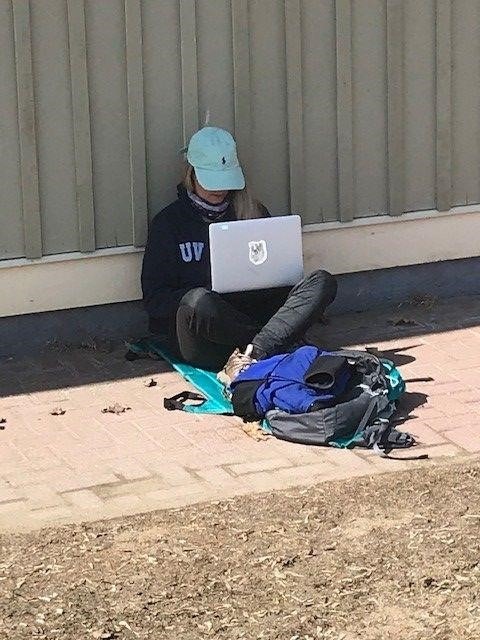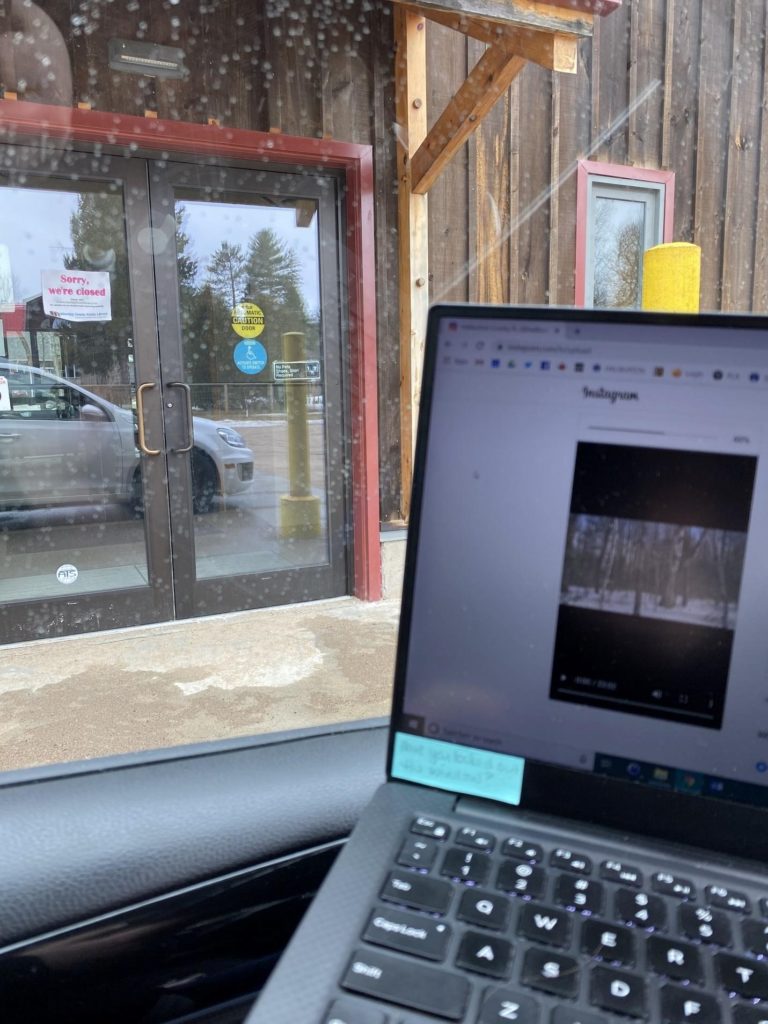COVID-19 has definitely created new access needs. Unfortunately, not everyone has a well-equipped home office that comes with internet access, which is where the public library can help.

The wrong side of the digital divide
By Bessie Sullivan and Erin Kernohan-Berning
Late in March the Editor-in-Chief of Open Shelf, Martha Attridge Bufton, sent me this article: With schools closed, library parking lots are some families’ only place for internet. Since my column for Open Shelf is predominantly about the unique challenges of rural public libraries, Martha thought it would be of interest to me. The article is from Wisconsin and subtitled, “Rural libraries now ‘a critical lifeline’ to those without internet.” However, you don’t have to live in Wisconsin for the public library parking lot to be the only source of Wi-Fi available to you. This is a common rural issue. Library Wi-Fi has always been a critical lifeline for many, but the current COVID crisis is further proof of this reality.
There are many free hot spots to be found in an urban landscape, but this isn’t quite true in a rural community. Haliburton County is a large landmass with about 20,000 permanent residents. We have seven library branches sprinkled over an area that takes more than an hour and a half to cross. All seven branches have as much wireless capacity as possible for their respective areas, but there nevertheless are several reasons why many of our residents still don’t have internet access.
Three factors are responsible. First is the geographical topography. In some areas access to the internet is almost impossible, or if it is available it is not high speed. Then there are socioeconomic considerations; the average family survives on less than a reasonable living wage. Finally there is the lack of population density; due to the expense involved, internet providers are just not interested in bringing the necessary infrastructure down a road for only one or two families.
Our patrons
COVID-19 has definitely created new access needs. Similar to the experience in Wisconsin, as soon as all educational institutions in our area ceased all in-person operations, an online platform was launched. This meant all students from kindergarten to post-secondary required adequate access to the internet. It also meant that the places where they were previously accessing broadband, i.e. school buildings, were also unavailable.
Throughout the course of this crisis, I have been the only staff member consistently using the library administration office to work. Currently, there are three people in my house relying on the internet (both of my adult children are in graduate programs and their studies continue). Even going from a $50 a month plan to a $120 a month plan does not give us enough capacity to run three Zoom meetings at once. Unlike many of my colleagues here, I only have a five-minute commute so I have been opting to go to the office to partially alleviate the strain at home (and not just on the internet).
Because I’m at the library most days I started noticing the activities around the branch.
Two young men would set up on our patio on Monday, Wednesday, and Friday at 1:00 p.m. I decided to see if they would talk to me. I left my card with them and asked them to email me if they were willing to tell me about what they were doing. (Not creepy at all).
This is what I got:

“I am one of the students who was using your Wi-Fi here today, April 3. I am in the Bachelor of Music program at Western University, and I have been using the Wi-Fi a few times a week for an average of about an hour and a half for each session since the university closed. I have needed it for conference calls using the program Zoom for my lectures…I have been incredibly grateful for the use because, in the part of the Minden/Carnarvon area in which my family lives, the internet is too slow to do what would be necessary to complete classwork and lectures.” ~ Gabriel
Gabriel also told me that being a music student means downloading a lot of music-something that he couldn’t do at home.

This woman agreed to talk to me and allowed me to take her picture, but I never got her name. She came prepared with a padded mat to sit on and snacks and drinks for a good long stay.
Many health services are located in communities an hour or more from where we live. Because personal visits to surrounding communities have been limited, this can be difficult. Instead, residents have the option of accessing some services online. Many people have learned how to do banking and groceries online in order to maintain social distancing. Mass job loss has necessitated connecting to government services like EI and CERB via the internet; reliable internet access has become a necessity.
We have opted to have our hot spot on 24/7 with no library membership needed and welcome the use of our outdoor plugs. Every day there are cars parked in our lot that arrive at different times and stay for extended periods.
How is our staff fairing?
Erin Kernohan-Berning is our Deputy CEO and she has found the lack of broadband where she lives not only a personal challenge but a professional one as well. Erin lives a considerable distance from her closest branch, and this is what she has to say from an operational perspective.
Since closing our buildings in March, we have been busy turning what was primarily a traditional service with some digital trimmings into an entirely digital service, as well as providing staff with online training opportunities so they can continue to work. One of the challenges of this has been dealing with staff who live on the wrong side of the digital divide, myself included.
A few HCPL staff members do not have internet at home. Where we could previously mass email staff and say something once, we now have additional phone calls to make. Even though it is nice to hear their voices, we’re managing two streams of communication instead of one.
HCPL also has a number of staff managing content creation online, producing virtual storytimes, maker activities, and how-to’s from their living rooms and kitchen tables. For one staff member, who is doing the bulk of our daily storytime sessions, it takes hours to upload her pre-recorded videos because of her slow internet connection. I’ve also had difficulty syndicating these efforts to other platforms because even though I could afford a better internet connection, one is not available to me.
Another challenge is that regionally our networks are feeling the pinch. With more people working from home and using their internet connections more intensively, entire towns are reporting slowdowns in their internet speed during peak times. One of our Wi-Fi hotspots drops frequently as people who would normally have traveled out of town for work stay home, which puts strain on the DSL network.
Here’s an anecdote to show you what it’s like to work at home on the wrong side of the digital divide:
“I wanted to upload one of our story times to Instagram, but the upload kept failing. Repeated tries yielded the same results. So, I decided to drive to my local branch and use their fibre connection from the parking lot. I parked as close to the building as I could, and my video uploaded like a hot knife through butter, but the video failed to process properly. As I went to download a fresh copy of the video from our shared drive, the internet at the branch went down. Because there is also no cell reception in the area, I had to drive back home to submit the help desk ticket to our IT department so they could remote in and reboot the access point. What would take less than an hour in an urban area with good high-speed internet and cellular coverage took me the better part of a day and a round trip by car with nothing to show for my effort. Living on the wrong side of the digital divide makes certain tasks Sisyphean.” Unfortunately, not everyone has a well-equipped home office that comes with internet access.

Unfortunately, not everyone has a well-equipped home office that comes with internet access.
What the statistics tell us
The Canadian Internet Registration Authority (CIRA) did a survey on internet use during COVID-19 and their results reflect what we have been experiencing. They found that:
- 70% of respondents are spending more time streaming video.
- Over half of Canadians are spending more time using video or teleconference technology to connect with others.
- Nearly half of all households report having two or more people working at home due to COVID-19.
- A quarter of respondents reported using improvised workspaces (i.e.: they had no established home office prior to COVID-19).
- The number of Canadians working from home has grown seven-fold.
- 38% of respondents said their home internet speed is slower than before social distancing began.
(Source: CIRA. Accessed 2020-04-16.)
The Eastern Ontario Warden’s Caucus (EOWC) has been working with industry to try and expand high-speed internet to at least 95% of homes and businesses in Eastern Ontario. The EOWC says: “We now depend on the Internet for everything from entertainment and business to education and health services. It is so essential that even the United Nations has declared Internet access a human right. However, not all Internet access is created equal. Many people in rural Eastern Ontario were prone to slow Internet connections that did not support today’s innovations.” (Accessed 2020-04-16.)
- 40% of rural Eastern Ontario does not have access to service that allows streaming high-definition video
- 20% does not have access to standard-definition video, typical mobile app use, and video app calling
- 10% has no voice calling service
(Source: EORN. Accessed 2020-04-20).
The COVID-19 pandemic has, as in many areas of our lives, cast a spotlight on the inequalities that we already knew were there, the digital divide included. Efforts such as those undertaken by the EOWC have led to many improvements. Their municipal broadband project resulted in the installation of fibre internet for almost all of our branches and created a backbone that allowed a telecom company to start offering fibre service to residents. However, even the highest speeds available in our area are slow compared to what is available in urban areas. At the current pace of technology, it doesn’t take long for good enough to become inadequate.
If internet access is not declared essential public infrastructure and we rely on the benevolence of for-profit enterprise, rural areas will always be on the wrong side of the digital divide.
Bessie Sullivan is the CEO of the Haliburton County Public Library. She can be reached at bsullivan [at] haliburtonlibrary.ca.
Erin Kernohan-Berning is the Branch Services Librarian/Deputy CEO at the Haliburton County Public Library. She earned her MLIS from Western University. She also holds a M.Sc. (Strathclyde), and is a graduate of the Advancing Public Library Leadership (APLL) program through SOLS. She has worked in special, academic, and public libraries, as well as in the tourism, heritage, and culture sectors.
